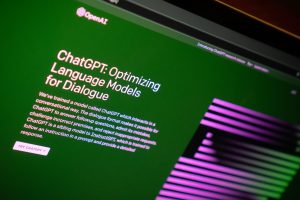Image Credit: © Tada Images / Adobe Stock
In the domains of artificial intelligence, language models have gained a special degree of prominence for allowing computing systems to assess, analyze, and interpret language-based communications to a great deal of efficiency. With growing capabilities in natural language processing and better computing power, the advancements in language models have been rapid in recent times. Widespread capabilities in the field were especially visible with the seemingly robust features of GPT-3 and 3.5 powered chatbot ChatGPT. The next iteration in the GPT series—GPT-4—was launched recently, promising further advancements and improvements to its users. The development comes during a period of speculation regarding the increasing role of AI technology in human spheres of life. OpenAI, the algorithm’s parent company claims to have further enhanced the capabilities of their sought-after language model in the next iteration, keeping chatter abuzz regarding the nature and computational aspects of GPT-4.
Updated and now trained on a gargantuan database of innumerable user prompts and complex responses, the evolved version of the widely used ChatGPT is set to change several ways in which the algorithm responds and decodes user requests. Though currently available only to paid users, companies partnered with OpenAI, its eventual release to the larger public might just bring with it numerous implications for its users. The subsequent sections will discuss the advancements that have brought forth complex language models such as GPT-4 and what it brings to the table, making it better and faster when compared to its predecessors.
What is GPT-4?

OpenAI continues to develop and improve its language models based on data and user feedback.
Built by OpenAI, GPT-4 is the fourth iteration of the GPT series language models created by the firm. Primarily centered around generating text-based responses for prompts entered by users, the algorithm is highly efficient and capable of providing answers from its vast database. Alongside this, the language model has trained on an array of prompts entered by human beings, enabling it to adjust its capabilities to respond creatively. As claimed by its parent company, GPT-4 integrates its approach and brings together higher accuracy and superior reasoning capabilities endowed by advanced machine learning processes. Improving ChatGPT’s mathematical abilities, GPT-4 is also far more efficient at solving complex math problems and answering numerous standardized tests with efficiency. The experience gained from previous iterations of the GPT series language models has allowed OpenAI to leverage these strengths and siphon them into the latest edition of the chatbot.
Apart from more factually accurate information in its responses, GPT-4 is also more ethically sound in its ability to refuse responses to harmful prompts or those that violate OpenAI’s policies. Regular feedback from the millions of users that have been interacting with its predecessor—ChatGPT—has also been integrated into the algorithm to allow for a more user-centric and smooth experience. However, given that the language model is now scaling inconceivable heights, several technical and economic experts have also raised concerns regarding the chatbot’s impact on tasks that it might be used to automate. OpenAI has already begun integrating GPT-4 with partner companies, enhancing their capabilities to produce fact-based content with greater accuracy when compared to GPT-3 and other language models in the series.
A List of GPT-4’s Capabilities

GPT-4 has supposedly improved upon many concerns that were frequently raised by users of ChatGPT.
Though OpenAI has not released the full technical details of GPT-4, the algorithm has shown a vast set of impressive capabilities, all thanks to its advanced natural language processing potential derived from voluminous amounts of data. Below are some of the most striking features of the new language model.
Multimodal Inputs
Unlike ChatGPT, GPT-4 is a multimodal language model that can interpret not only text-based prompts but also ones that contain images. Formerly, other GPT series algorithms only accepted text-based prompts and were fairly limited when it came to users having to describe visual information to the chatbot; however, with the launch of GPT-4, users are now better equipped to obtain information derived from a largely visual prompt uploaded to the interface.
Multilingual Capabilities
While even older GPT series algorithms were capable of showcasing a basic understanding of languages other than English, GPT-4 shows impressive multilingual capabilities that extend to even decoding prompts that contain multiple languages. Not only does this aid with translation processes but also allows the language model to help users access the tool in their native languages, furthering the algorithm’s learning curve and utility.
Improved Accuracy
GPT-4 claims to be more factually accurate when compared to its predecessors such as ChatGPT. The improved capabilities and integration of user feedback have made it possible for the developers to integrate better reasoning mechanisms within the AI to allow it to provide better-quality answers to its users. Though GPT-4 is still not 100% reliable, it still makes a fair amount of improvements and fares better when compared to GPT-3 and GPT-3.5, which ChatGPT functions on.
Improved Processing Capabilities
One of the main drawbacks of ChatGPT from the user perspective was its tendency to become overburdened by prompts and its usual inability to analyze long-form prompts. OpenAI seemingly addresses these concerns in its successor, making GPT-4 capable of handling a larger volume of requests alongside maintaining coherence and fidelity even while sustaining long conversations or when producing long-form content for its users.
Improved Security
Apart from better processing and reasoning features, OpenAI also claims to have trained GPT-4 to be more resilient to commands and prompts that might cause it to behave erratically or produce results that propagate misinformation. It is also more resilient to prompts that tend to trick language models into providing responses that might be unethical or biased. GPT-4 remains rooted in the policy of OpenAI and does not go off-track when posed with potentially malicious content or prompts.
GPT-4’s Limitations

Despite improvements, GPT-4 too is prone to pitfalls.
Despite the impressive improvements in the latest iteration of GPT series language models, several limitations that applied to its predecessors still hold for GPT-4. OpenAI’s latest offering is still prone to reasoning errors, provides information that might be dubious, and is also prone to bias, albeit to a lesser degree when compared to ChatGPT. This necessitates both caution and an informed approach. Though the new improvements on GPT-4 are indicative of a long-running process of continued research and attunements required in creating robust language models, the true implications of generative AI will still need to be studied at length and analyzed by experts from numerous disciplines. As the world of AI continues to witness rapid change and a period of flux, academicians and students must watch out to ensure that larger interests are not compromised for the sake of adopting newer technologies and must instead prioritize a balanced approach before considering the integration of language models.
